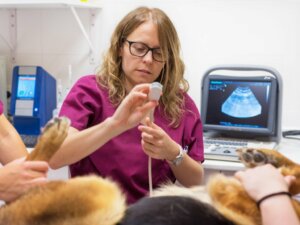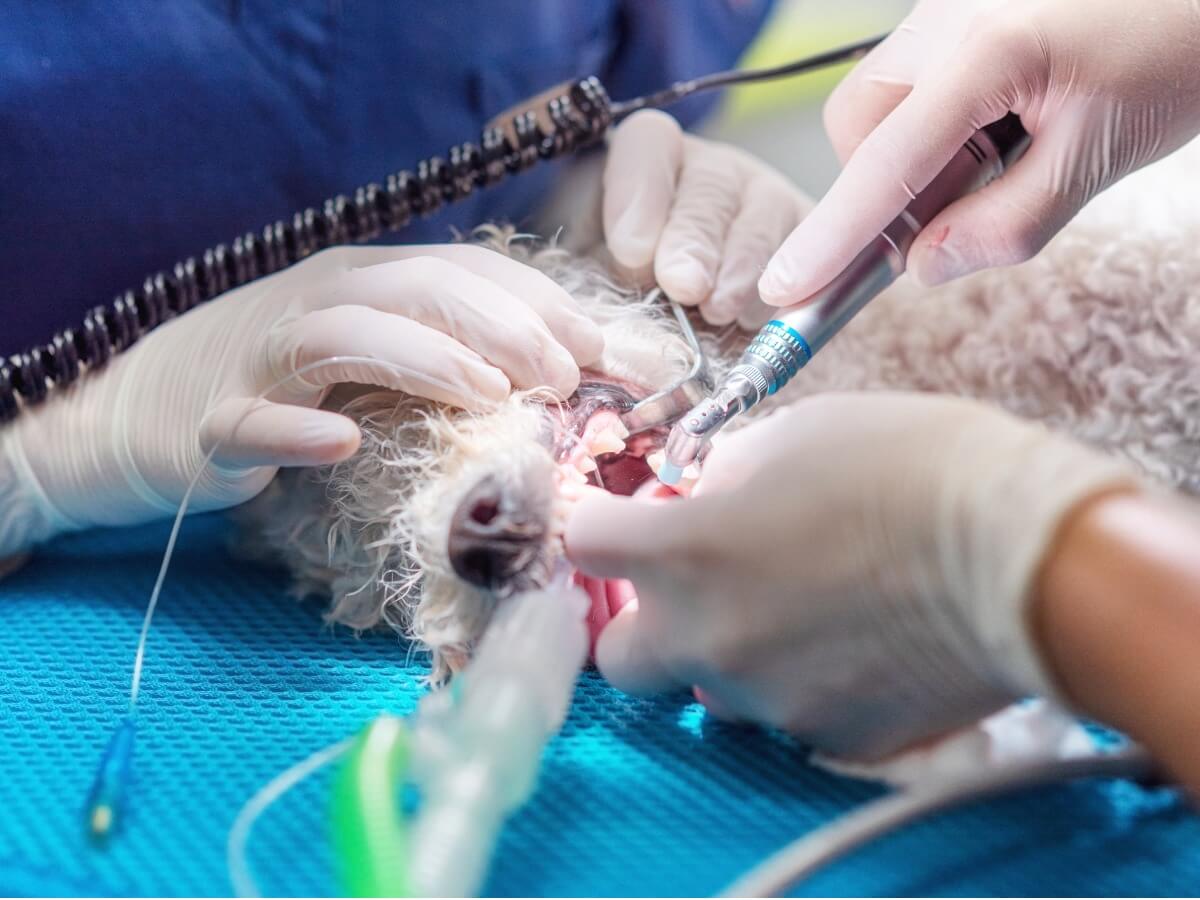Cleft Palate in Dogs: Causes and Treatment

Like any living being, dogs can suffer from congenital or hereditary diseases. This means that there are diseases that are transmitted from parents to children, causing symptoms that seriously affect the animal’s quality of life. Among all these pathologies, cleft palate in dogs stands out as a physical malformation that, in puppies, can be lethal.
In principle, this error in the formation of the oral-nasal cavity doesn’t represent a danger in itself. The problem lies in the difficulties that the dog has to feed itself when manifesting the clinical signs of this heritable condition. Discover with us the characteristics of the disease, its symptoms and available treatments.
Problems in the mouth-nose region of dogs
The most common hereditary pathologies in dogs are those that affect the oral cavity and its attachments. Among all of them, cleft lip and cleft palate are the most common, in addition to being related to each other – having the same origin during pregnancy. In general, the problem manifests itself between the fourth and twelfth week of the embryo’s gestation.
These abnormalities are present in any breed, both dogs and cats. However, they affect to a greater extent those that have a different skull than the rest – also called brachycephalic breeds. This is because the modification of your face, mouth, nose and ducts leads to a greater susceptibility to these types of congenital diseases.
It is believed that, apart from their genetic component, these types of diseases are also caused by environmental and nutritional factors. For example, mineral and vitamin A deficiencies in the maternal diet can impact the development and formation of palate structures in puppies.
The degree of these pathologies varies greatly between patients. Depending on its severity, puppies can have minimal or serious effects on their quality of life. Unfortunately, most of those affected die or are killed by breeders.
Cleft palate and other conditions cause problems with the puppy’s sucking of food. Therefore, the survival rate is very low.

What is a cleft palate?
The palate is the structure that divides the nasal and oral cavity. Because it covers a large part of the mouth, at least 2 sections are distinguished:
- Primary palate: Made up of the lip and the premaxilla (the tip of the jaw).
- Secondary palate: The structure that encompasses the hard and soft palate.
Viewed another way, the primary palate is restricted to the entrance of the mouth, while the secondary palate constitutes the upper internal part of the oral cavity. If we put these structures in order from the outside to the inside, the conformation is as follows: lip, premaxilla, hard palate, and soft palate.
Regarding the last sections, it should be noted that the hard palate is made up of bones and mucous tissue, while the soft is only the continuation of the structure, but without considering the bone. That is why the distinction is made between hard palate (with bone) and soft palate (without bone).
When we talk about the affectations in the oral cavity, we have to distinguish between the region that is affected. For this reason, congenital malformations of the palate are classified as primary or secondary cleft palate. Next, we’ll tell you the peculiarities of each condition.
Primary cleft palate or cleft lip
A cleft lip is due to failure in the joining of the facial membranes, resulting in an incomplete fusion of the upper lip. This causes a split in the lip – unilateral or bilateral – that leaves an opening and exposes part of the premaxilla. In addition, depending on the case, the malformation can affect the nose.
The consequences of this pathology are mild in most cases. It barely causes some oral infections or dental alterations, although not in all those affected. The most serious cases are the product of adding the cleft lip to the palatoschisis or cleft palate.
Secondary cleft palate or palatoschisis
The presence of an opening in the middle of the palate is called secondary cleft palate or palatoschisis. This derives from an error during embryonic development, which prevents the union of the palatal plates. In other words, it’s a “hole” along the top of the mouth, which can affect the hard palate, the soft palate, or both.
Symptoms of palatoschisis in dogs
The symptoms of cleft palate in dogs focus on breathing difficulties and feeding problems. This is a direct consequence of the additional communication that exists between the mouth and the nose, due to the indentation that exists. The malformation makes it impossible to carry out suction and causes fluid leakage into the nasal cavity.
In general, it’s recommended to see a veterinarian when detecting any of the following clinical signs:
- Nasal discharge: Runny nose due to excess fluid in the nose.
- Difficulty breastfeeding: Problems feeding on the mother’s milk.
- Nasal regurgitation of fluids or food: Leakage of swallowed food or liquid into the nasal cavity.
- Growth retardation: Caused by difficulty feeding.
- Aspiration pneumonia: This type of pneumonia is caused by fluid or food leaking into the airways. The presence of foreign matter in the respiratory tract causes an infection in the lungs.
The presence of these symptoms doesn’t necessarily mean that the diagnosis is cleft palate. However, they can alert us to the need to see a veterinarian and be able to rule out other diseases. In the end, only the professional is qualified to perform the physical examination of the oral cavity, confirming or rejecting the diagnosis.
Consequences of cleft palate in dogs
The consequences of this pathology can seriously affect the dog’s quality of life. This is a consequence of the difficult intake of food, as the animals lose weight and delay their growth. In addition, recurrent infections in the upper respiratory tract appear in these patients, due to the leakage of food and liquids into the nasal region.
It’s necessary to pay attention to the symptoms, since, even in the best of cases, the dog will suffer some nutritional deficit. However, in most cases, patients die when they are still puppies, because it’s impossible for them to feed.
Causes of the disease
This disease is of hereditary origin, since its clinical signs are transmitted from parents to children. However, a relationship has also been found with environmental factors, which can include exposure of the mother to X-rays and nutritional problems during development.
For any of these factors to cause a cleft lip, it would have to occur between the fourth and seventh week of gestation. As for the cleft palate, the trigger should appear between the seventh and twelfth week.
Treatment of cleft palate in dogs
The main treatment consists of a surgical operation, in which the objective is to reconstruct the nasal floor (palate). Through this procedure, veterinarians close the cleft and correct the deformity, both the soft and hard palate. After the intervention, the healing and recovery time is usually around a month.
Because this condition can be fatal in puppies, it’s recommended that the patient be a minimum of 8 to 12 weeks of age to perform the surgery. If the animal can’t feed efficiently, it’ll be necessary to use a gastrostomy tube or a prosthesis for the palate, in order to maintain its nutritional status and avoid growth retardation.
The prognosis of surgery is usually good, as long as the palate heals properly. Otherwise, new surgeries may be required, which lengthens the recovery time. After this, it’s also recommended to perform castration. Being a hereditary condition, this prevents the disease from prevailing in future generations.

Remember to consult your veterinarian if you have any doubts that may arise, as only a professional can give you adequate information about your particular case. Take the necessary precautions and pay attention to your pet, and, at any alarming signs, go to a professional. Give your dog the attention it deserves.
All cited sources were thoroughly reviewed by our team to ensure their quality, reliability, currency, and validity. The bibliography of this article was considered reliable and of academic or scientific accuracy.
- Sánchez, J. M. F., pedraja Marqués, M., & de la Morena Cabanillas, M. (2011). Tratamiento quirúrgico del paladar hendido secundario congénito en perro. Argos: Informativo Veterinario, (129), 32-34.
- Rebeca, S. H. (1986). Asociación de agenesia de paladar, anotia y polidactilia en una familia de perros de la raza san bernardo.
- Wijdeveld, M. G. M. M., Maltha, J. C., Grupping, E. M., De Jonge, J., & Kuijpers-Jagtman, A. M. (1991). A histological study of tissue response to simulated cleft palate surgery at different ages in beagle dogs. Archives of oral biology, 36(11), 837-843.
- Wolf, Z. T., Brand, H. A., Shaffer, J. R., Leslie, E. J., Arzi, B., Willet, C. E., … & Bannasch, D. L. (2015). Genome-wide association studies in dogs and humans identify ADAMTS20 as a risk variant for cleft lip and palate. PLoS Genet, 11(3), e1005059.
- Martínez-Sanz, E., Casado-Gómez, I., Martín, C., López-Gordillo, Y., González, P., Rodríguez-Bobada, C., … & Martínez-Álvarez, C. (2011). A new technique for feeding dogs with a congenital cleft palate for surgical research. Laboratory animals, 45(2), 70-80.
- García Arnas, F., Llorens, M. P., Prandi Chevalier, D., San Román Ascaso, F., & Peña Giménez, M. (1991). Palatosquisis en la especie canina. Clínica veterinaria de pequeños animales, 11(1), 0046-53.
- Sánchez, J. M. F., pedraja Marqués, M., & de la Morena Cabanillas, M. (2011). Tratamiento quirúrgico del paladar hendido secundario congénito en perro. Argos: Informativo Veterinario, (129), 32-34.
This text is provided for informational purposes only and does not replace consultation with a professional. If in doubt, consult your specialist.